A Novel Model of Ultrasonic Fatigue Test in Pure Bending
Abstract
:1. Introduction
2. Pure Bending Test Method
2.1. Composition of the Experimental System
2.2. Principle of Specimen Design for Ultrasonic Bending
2.3. Specimen Final Design with Numerical Simulation
3. Monitoring of the Fatigue Test
3.1. Stress Measurement
3.2. Temperature Monitoring
4. Experimental Results and Discussion
4.1. S-N Curve and Fracture Data Statistics
4.2. Fracture Morphology
5. Conclusions
- (1)
- Fatigue failure occurs at the gauge section, and the equivalent S-N curves are obtained after the effects of the crack section are taken into account. To confirm the validity of the novel method, the fracture results and fracture characteristics in this work are in agreement with those existing in the literature;
- (2)
- The harmonic model of second-order vibration provides an angle of rotation equal to zero, which significantly reduces the heat generation from friction at the connection area;
- (3)
- Following the tendency found in the LCF and the HCF, the S-N curves have an intersection between bending fatigue and uniaxial fatigue in the VHCF regime. However, unlike the uniaxial fatigue, the inner crack invitation vanished in the bending case for the test material.
Author Contributions
Funding
Institutional Review Board Statement
Informed Consent Statement
Data Availability Statement
Acknowledgments
Conflicts of Interest
References
- Tien, J.K. The State of Ultrasonic Fatigue. Int. J. Fatigue 1982, 4, 238. [Google Scholar]
- Brugger, C.; Palin-Luc, T.; Osmond, P.; Blanc, M. Gigacycle Fatigue Behavior of a Cast Aluminum Alloy Under Biaxial Bending: Experiments with a New Piezoelectric Fatigue Testing Device. Procedia Struct. Integr. 2016, 2, 1173–1180. [Google Scholar]
- Hopkinson, B. A High-Speed Fatigue-Tester, and the Endurance of Metals Under Alternating Stresses of High Frequency. Proc. R. Soc. London. Ser. A Contain. Pap. A Math. Phys. Character 1912, 86, 131–149. [Google Scholar]
- Jenkin, C.F.; Lehmann, G.D. High Frequency Fatigue. Proc. R. Soc. London. Ser. A Contain. Pap. A Math. Phys. Character 1929, 125, 83–119. [Google Scholar]
- Mason, W.P.; Baerwald, H. Piezoelectric Crystals and their Applications to Ultrasonics. Phys. Today 1951, 4, 23. [Google Scholar]
- Lutjering, G.; Nowak, H.; Nowack, H. Fatigue’96: Proceedings of the Sixth International Fatigue Congress; Elsevier Science & Technology: Amsterdam, The Netherlands, 1996; Volume II. [Google Scholar]
- Yang, B.; Yin, M.; Xiang, Z.; Yin, G. The Vibration Modal Analysis of Compressor Blades of Gas Turbines Under the Influence of Centrifugal Force Fields. Machinery 2018, 45, 31–36. [Google Scholar]
- Li, C.; Li, H.; Wang, C.; Zhang, Z.; Sun, J. A Study of Influencing Factors on Frequences and Mode Shapes of Aeroengine Turbine Blades. J. Air Force Eng. Univ. Nat. Sci. Ed. 2014, 15, 5. [Google Scholar]
- Ashok, S.; Federico, B.; Kevin, N.; James, C.N. On Single-Edge-Crack Tension Specimens for Tension-Compression Fatigue Crack Growth Testing. Eng. Fract. Mech. 2017, 176, 343–350. [Google Scholar]
- Xie, Q.; Liang, J.; Stoica, A.D.; Li, R.; Yang, P.; Zhao, Z.; Wang, J.; Lan, H.; Li, R.; An, K. In-Situ Neutron Diffraction Study on the Tension-Compression Fatigue Behavior of a Twinning Induced Plasticity Steel. Scr. Mater. 2017, 137, 83–87. [Google Scholar]
- Yang, Y.; Yi, J.; Yang, N.; Liang, W.; Huang, H.; Huang, B.; Jia, Y.; Bian, X.; Wang, G. Tension-Tension Fatigue Behavior of High-Toughness Zr61Ti2Cu25Al12 Bulk Metallic Glass. Materials 2021, 14, 2815. [Google Scholar]
- Habib, K.; Nishikawa, H.; Furuya, Y.; Emura, S. The Role of Crystallographic Texture and Basal Plane Slip on Microstructurally Short Fatigue Crack Initiation and Propagation in Forged Billet and Rolled Bar Ti-6Al-4V Alloy. Metall. Mater. Trans. A 2021, 52, 3821–3838. [Google Scholar]
- Sumigawa, T.; Byungwoon, K.; Mizuno, Y.; Morimura, T.; Kitamura, T. In Situ Observation on Formation Process of Nanoscale Cracking During Tension-Compression Fatigue of Single Crystal Copper Micron-Scale Specimen. Acta Mater. 2018, 153, 270–278. [Google Scholar]
- Xu, X.; Ding, H.; Li, W.; Huang, H.; Liang, H.; Chen, R.; Guo, J.; Fu, H. The Microstructure and High Cycle Fatigue Performance of As-Cast and Directionally Solidified Ti46Al7Nb Alloy Under the Three-Point Bending Loading. Mater. Sci. Eng. A 2021, 822, 141633. [Google Scholar]
- Ma, M.; Yao, W.; Jiang, W.; Jin, W.; Chen, Y.; Li, P. A Multi-Area Fatigue Damage Model of Composite Honeycomb Sandwich Panels Under Three-Point Bending Load. Compos. Struct. 2021, 261, 113603. [Google Scholar]
- Yoshihiko, U.; Toshifumi, K.; Shinya, T.; Satoshi, M.; Kazuhiro, T. Fatigue Behavior of AZ31 Magnesium Alloy Evaluated Using Single Crystal Micro Cantilever Specimen. Int. J. Fatigue 2016, 93, 30–37. [Google Scholar]
- Toshifumi, K.; Yoshihiko, U.; Shinya, T.; Satoshi, M. Effect of Grain Orientation on Fatigue Behavior in Micro Cantilever of Magnesium Alloy AZ31. Procedia Mater. Sci. 2014, 3, 967–972. [Google Scholar]
- Menzemer, C.C.; Azzam, D.; Srivatsan, T.S. A Study of Fatigue and Fracture Response of Cantilevered Luminaire Structures Made From Aluminum Alloy 6063. Mater. Sci. Eng. A 2010, 527, 4680–4686. [Google Scholar]
- Xu, Z.; Zhang, H.; Yan, Z.; Liu, F.; Liaw, P.K.; Wang, W. Three-Point-Bending Fatigue Behavior of AZ31B Magnesium Alloy Based On Infrared Thermography Technology. Int. J. Fatigue 2017, 95, 156–167. [Google Scholar]
- Costa, P.; Nwawe, R.; Soares, H.; Reis, L.; Freitas, M.; Chen, Y.; Montalvão, D. Review of Multiaxial Testing for Very High Cycle Fatigue: From ‘Conventional’to Ultrasonic Machines. Machines 2020, 8, 25. [Google Scholar]
- Bathias, C. Piezoelectric Fatigue Testing Machines and Devices. Int. J. Fatigue 2005, 28, 1438–1445. [Google Scholar]
- Liu, Y.; He, C.; Yang, S.; Wang, Q. Study on an Ultrasonic Bending Fatigue Testing Method for Thin Sheet. J. Sichuan Univ. Eng. Sci. Ed. 2012, 44, 154–157. [Google Scholar]
- Hu, Y.; Chen, Y.; He, C.; Liu, Y.; Wang, Q.; Wang, C. Bending Fatigue Behavior of 316L Stainless Steel up to Very High Cycle Fatigue Regime. Materials 2020, 13, 4820. [Google Scholar]
- Kossa, A.; McMeeking, R.M. Bending of a Nitinol Cantilever and its Fatigue Performance. Extrem. Mech. Lett. 2021, 42, 101083. [Google Scholar]
- Fan, J. Infrared Thermographic Method to Rapidly Evaluate High-Cycle Fatigue Behavior of Welded Joints. Infrared Phys. Techn. 2021, 117, 103850. [Google Scholar]
- Huang, J.; Pastor, M.; Garnier, C.; Gong, X. A New Model for Fatigue Life Prediction Based on Infrared Thermography and Degradation Process for CFRP Composite Laminates. Int. J. Fatigue 2019, 120, 87–95. [Google Scholar]
- Liu, F.; Chen, Y.; He, C.; Wang, C.; Li, L.; Liu, Y.; Wang, Q. Very Long Life Fatigue Failure Mechanism of Electron Beam Welded Joint for Titanium Alloy at Elevated Temperature. Int. J. Fatigue 2021, 152, 106446. [Google Scholar]
- Wu, H.; Lei, H.; Frank, C.Y. Comparison on Mechanisms of High-Cycle Fatigue Performance of Structural Steel Exposed to Urban Industrial Atmosphere and Laboratory Simulated Corrosive Environment Based on Infrared Thermography. Int. J. Fatigue 2021, 145, 106098. [Google Scholar]
- Deng, H.; Guo, Y.; Liu, H.; Liu, Q.; Guo, Y.; Yu, H. Bending Fatigue Life Prediction Model of Carburized Gear Based on Microcosmic Fatigue Failure Mechanism. J. Mater. Eng. Perform. 2021, 31, 882–894. [Google Scholar]
- Kurek, A.; Łagoda, T.; Kurek, M. Stress Gradient as a Size Effect in Fatigue Life Determination for Alternating Bending. Int. J. Fatigue 2021, 153, 106461. [Google Scholar]
- Shen, J.; Fan, H.; Wang, J.; Yu, C.; Huang, Z. A Fatigue Life Evaluation Method for Notched Geometries Considered the Stress Gradient Concept. Int. J. Fract. 2022, 234, 81–96. [Google Scholar]
- Zuo, J.H.; Wang, Z.G.; Han, E.H. Effect of Microstructure on Ultra-High Cycle Fatigue Behavior of Ti–6Al–4V. Mater. Sci. Eng. A 2008, 473, 147–152. [Google Scholar]
- Shen, T.; Park, K.; Choi, J.; Moon, B.; Koo, J.; Seok, C. Evaluation for Fracture Resistance Curves of Nuclear Real Pipes Using Curved Equivalent Stress Gradient (Curved ESG) Specimens. Eng. Fract. Mech. 2017, 169, 89–98. [Google Scholar]
- Nakajima, M.; Tokaji, K.; Itoga, H.; Shimizu, T. Effect of Loading Condition on Very High Cycle Fatigue Behavior in a High Strength Steel. Int. J. Fatigue 2010, 32, 475–480. [Google Scholar]
- Jeddi, D.; Palin Luc, T. A Review About the Effects of Structural and Operational Factors on the Gigacycle Fatigue of Steels. Fatigue Fract. Eng. Mater. 2018, 41, 969–990. [Google Scholar]
- Cui, W.; Chen, X.; Cheng, L.; Ding, J.; Wang, C.; Wang, B. Microstructure and Fatigue Properties of TC4 Titanium Alloy Treated by A+ Β Forging Process. IOP Conf. Ser. Earth Environ. Sci. 2021, 772, 012075. [Google Scholar]
- Wang, B.; Cheng, L.; Cui, W.; Chen, X.; Wang, C.; Li, D. Effect of Forging Process on High Cycle and Very High Cycle Fatigue Properties of TC4 Titanium Alloy Under Three-Point Bending. Fatigue Fract. Eng. Mater. 2021, 44, 2054–2069. [Google Scholar]
- Wang, B.; Cheng, L.; Li, D. Experimental Study on Forged TC4 Titanium Alloy Fatigue Properties Under Three-Point Bending and Life Prediction. Materials 2021, 14, 5329. [Google Scholar]
- Li, W.; Zhao, H.; Nehila, A.; Zhang, Z.; Sakai, T. Very High Cycle Fatigue of TC4 Titanium Alloy Under Variable Stress Ratio: Failure Mechanism and Life Prediction. Int. J. Fatigue 2017, 104, 342–354. [Google Scholar]
- Bi, S.; Liu, Z.Y.; Xiao, B.L.; Xue, P.; Wang, D.; Wang, Q.Z.; Ni, D.R.; Ma, Z.Y. Different Fatigue Behavior Between Tension-Tension and Tension-Compression of Carbon Nanotubes Reinforced 7055 Al Composite with Bimodal Structure. Carbon 2021, 184, 364–374. [Google Scholar]
- Liu, F.; He, C.; Chen, Y.; Zhang, H.; Wang, Q.; Liu, Y. Effects of Defects on Tensile and Fatigue Behaviors of Selective Laser Melted Titanium Alloy in Very High Cycle Regime. Int. J. Fatigue 2020, 140, 105795. [Google Scholar]
- Takeuchi, E.; Furuya, Y.; Nagashima, N.; Matsuoka, S. The Effect of Frequency on the Giga-Cycle Fatigue Properties of a Ti–6Al–4V Alloy. Fatigue Fract. Eng. Mater. 2008, 31, 599–605. [Google Scholar]
- Pintado, C.N.; Vázquez, J.; Domínguez, J.; Periñán, A.; García, M.H.; Lasagni, F.; Bernarding, S.; Slawik, S.; Mücklich, F.; Boby, F. Effect of Surface Treatment on the Fatigue Strength of Additive Manufactured Ti6Al4V Alloy. Frat. Ed Integrità Strutt. 2020, 14, 337–344. [Google Scholar]



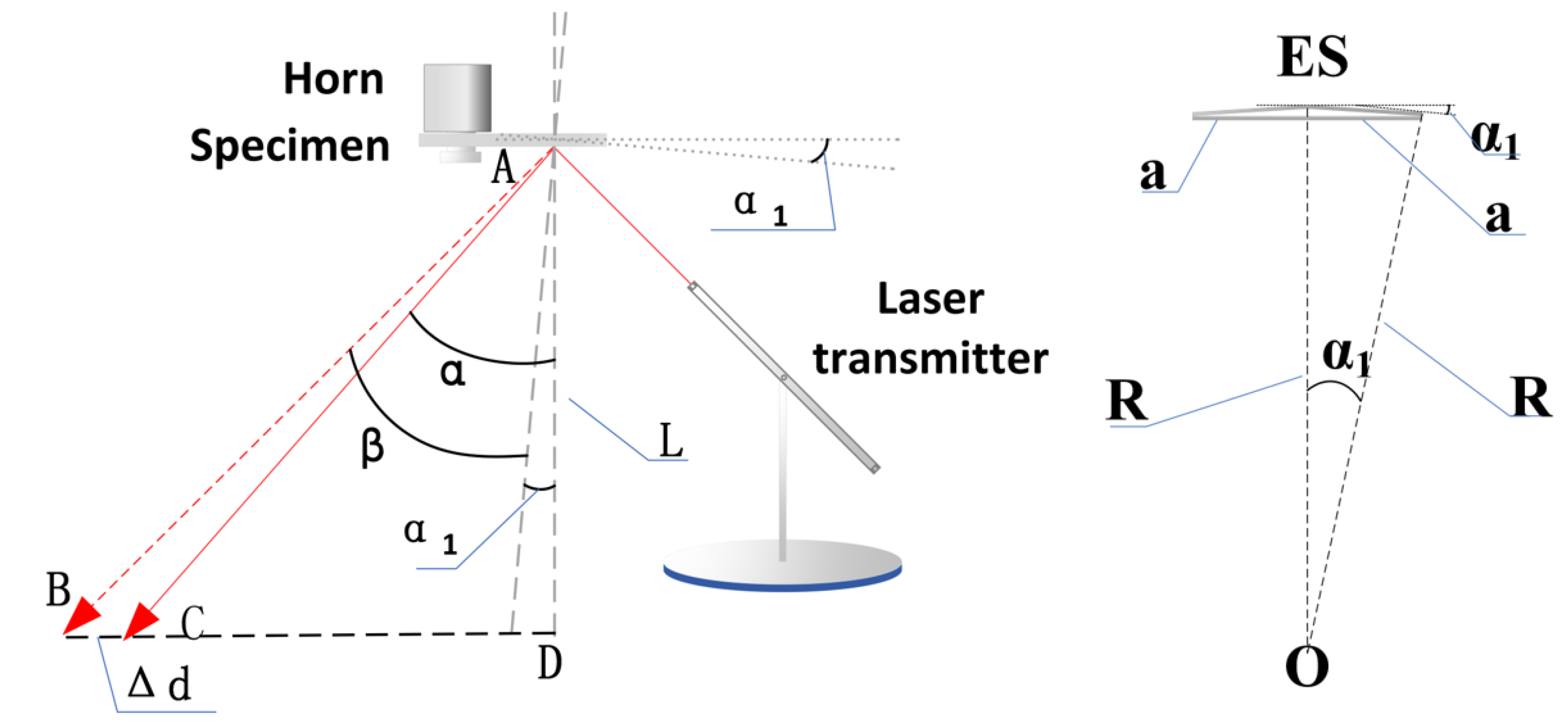
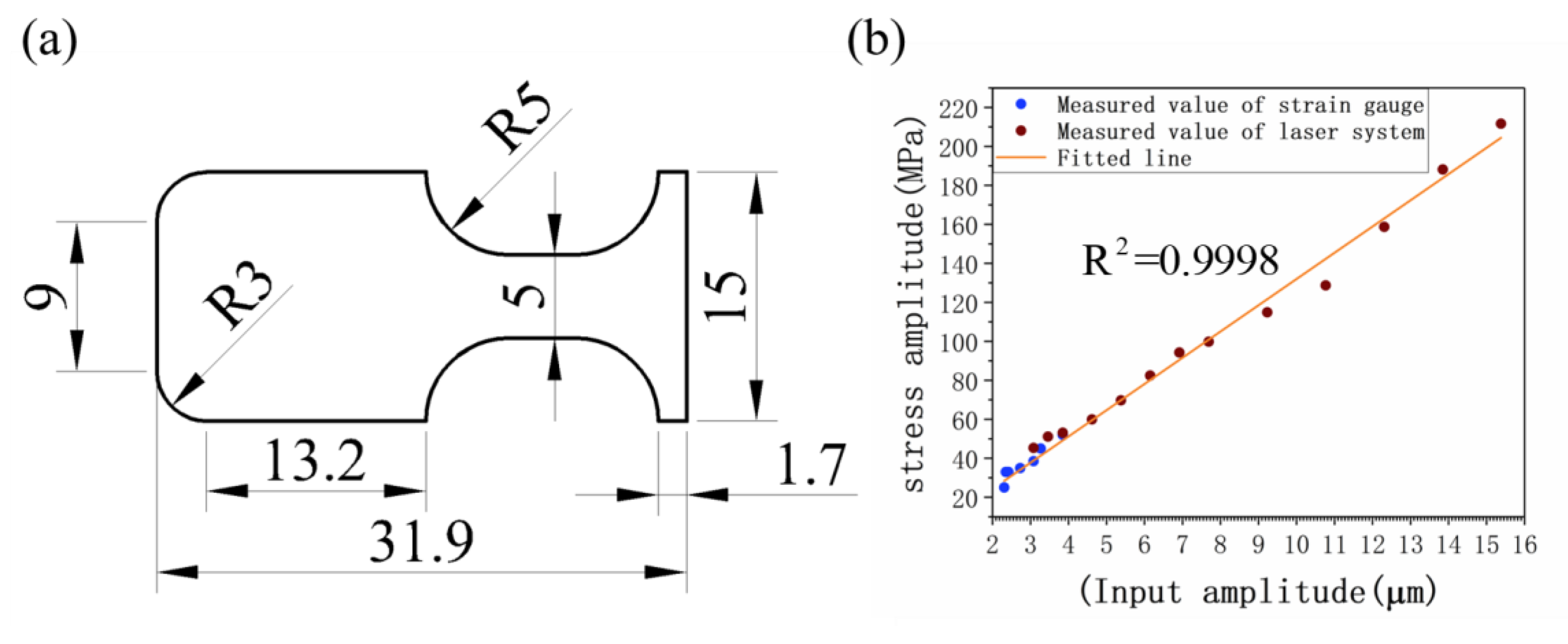
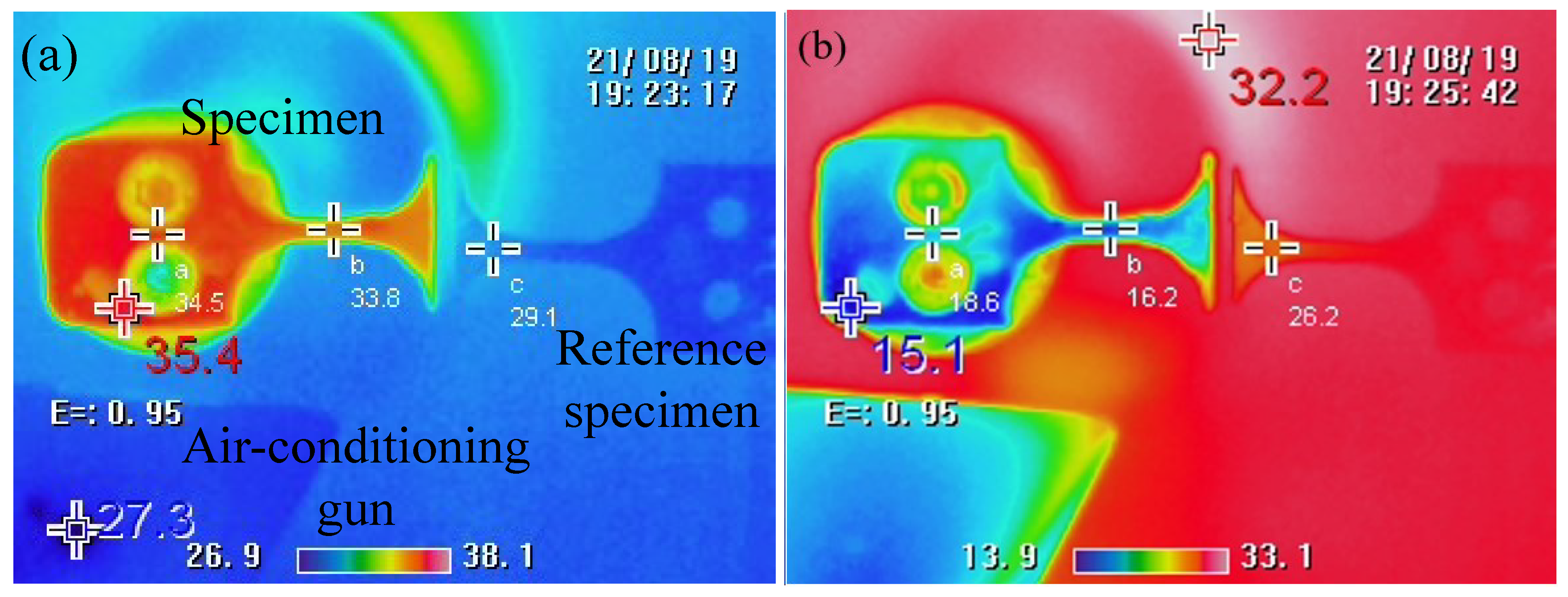
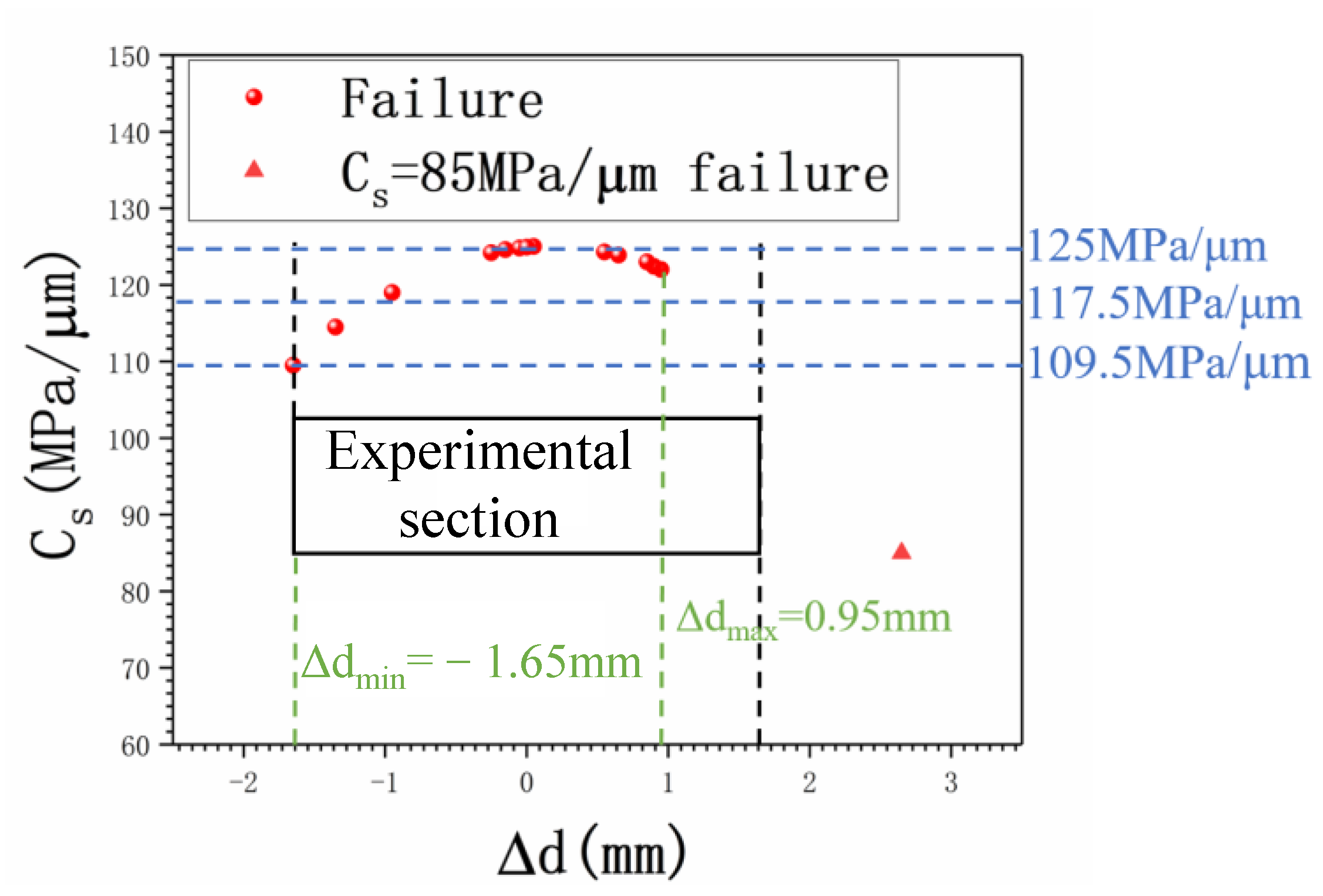
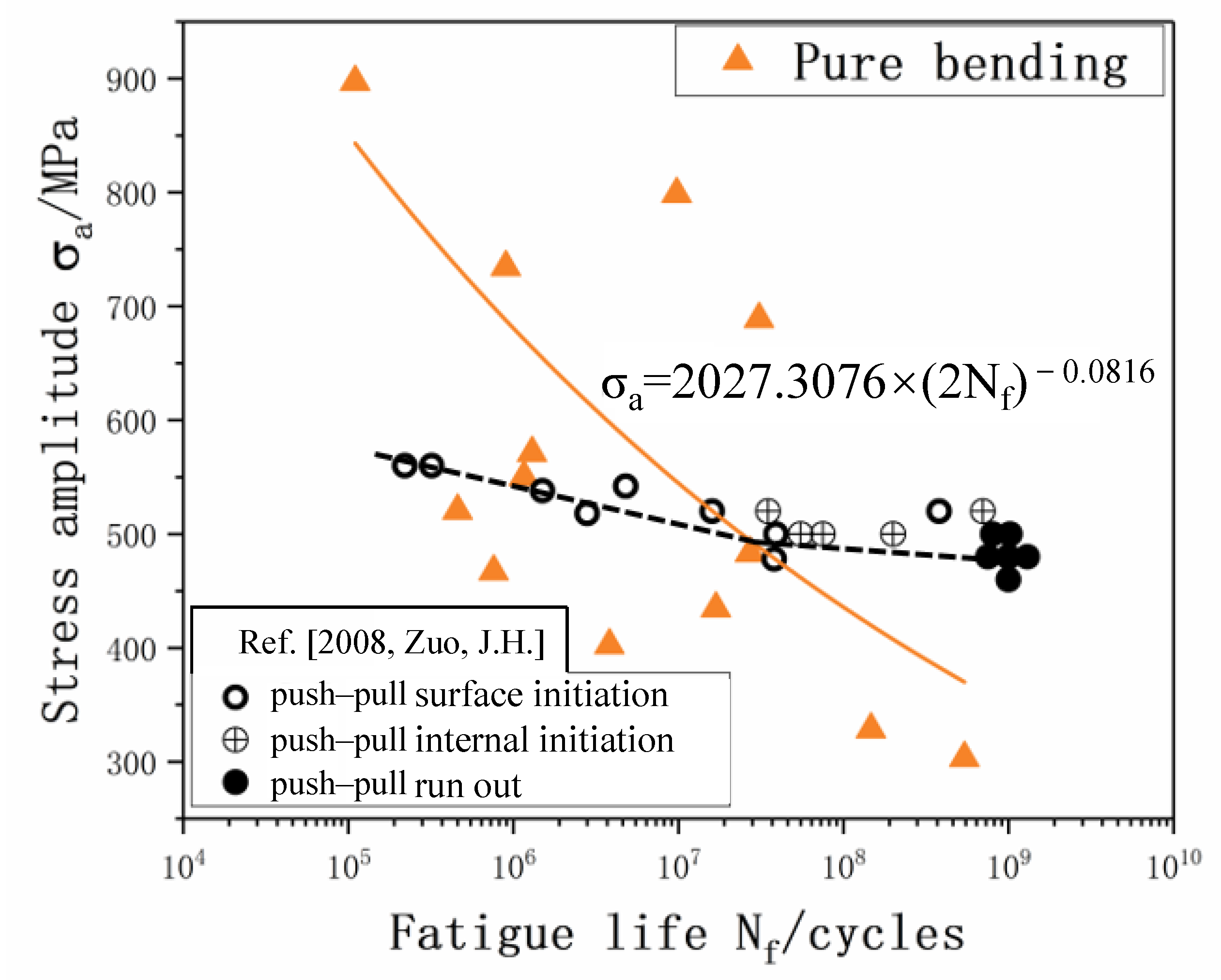



Publisher’s Note: MDPI stays neutral with regard to jurisdictional claims in published maps and institutional affiliations. |
© 2022 by the authors. Licensee MDPI, Basel, Switzerland. This article is an open access article distributed under the terms and conditions of the Creative Commons Attribution (CC BY) license (https://creativecommons.org/licenses/by/4.0/).
Share and Cite
Yang, D.; Tang, S.; Hu, Y.; Nikitin, A.; Wang, Q.; Liu, Y.; Li, L.; He, C.; Li, Y.; Xu, B.; et al. A Novel Model of Ultrasonic Fatigue Test in Pure Bending. Materials 2022, 15, 4864. https://doi.org/10.3390/ma15144864
Yang D, Tang S, Hu Y, Nikitin A, Wang Q, Liu Y, Li L, He C, Li Y, Xu B, et al. A Novel Model of Ultrasonic Fatigue Test in Pure Bending. Materials. 2022; 15(14):4864. https://doi.org/10.3390/ma15144864
Chicago/Turabian StyleYang, Dongtong, Sen Tang, Yongtao Hu, Alexander Nikitin, Qingyuan Wang, Yongjie Liu, Lang Li, Chao He, Yan Li, Bo Xu, and et al. 2022. "A Novel Model of Ultrasonic Fatigue Test in Pure Bending" Materials 15, no. 14: 4864. https://doi.org/10.3390/ma15144864






